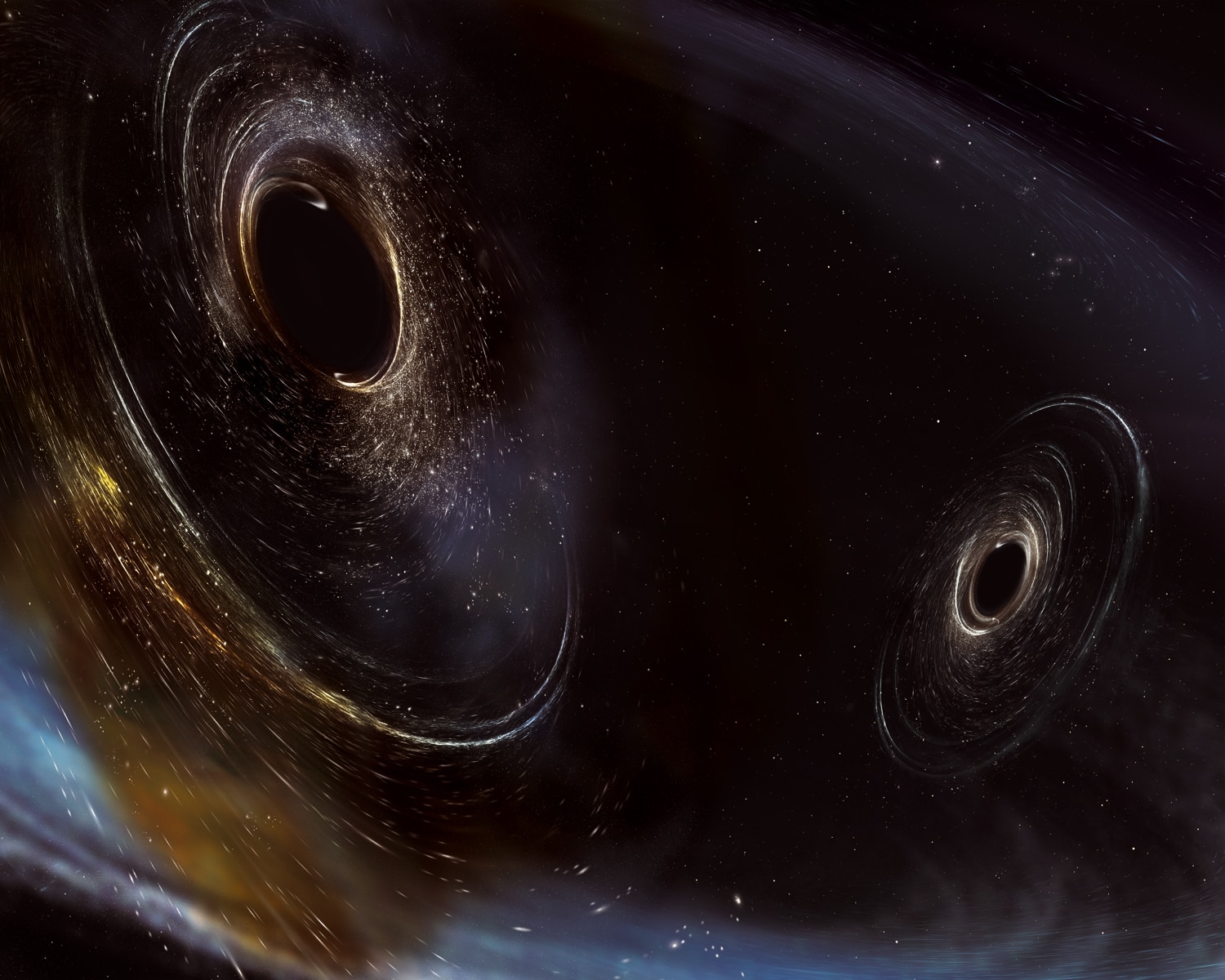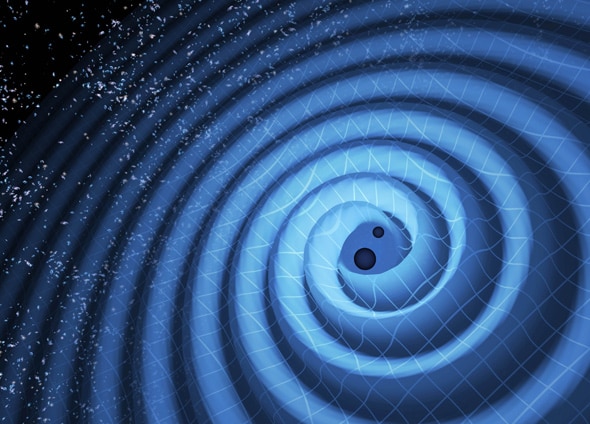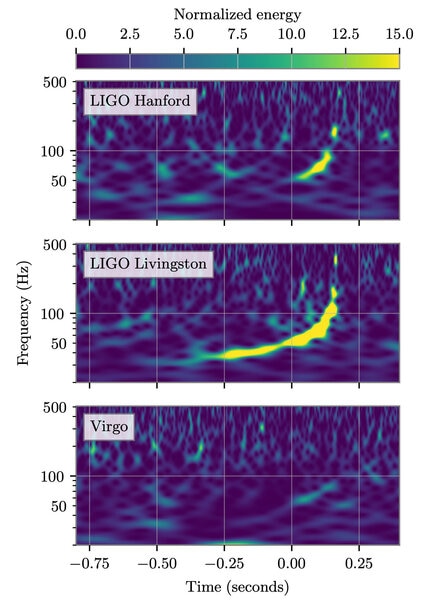Create a free profile to get unlimited access to exclusive videos, sweepstakes, and more!
Two black holes merged into one, singing in tune the whole time

On 12 April, 2019, the song from a pair of merging black holes swept over the Earth. And, for the first time, we detected them singing in tune.
Or, for a more prosaic description: Two black holes of very different sizes merged, shaking the fabric of spacetime in sympatico. They — oh wait. That's still a little poetic, isn't it? OK, let me try this then:
Across the Universe, two black holes of unequal masses spiraled into each other, sending out harmonic waves of gravitational wave energy, their resonating vibrations merging into a chord that — oh nuts. <sigh> I did it again.
This is going to be a problem. Let me see if I can back out a little and tell you what's going on more scientifically.
One of Einstein's weirder predictions from the General Theory of Relativity is that if two masses orbit each other, they literally shake the fabric of spacetime, creating ripples in it that expand outward at the speed of light. It's a bit like grabbing the corners of a towel and flapping it; ripples move away from you as they travel through the fabric.
Space does this too. The more massive and faster the objects move, the more powerful the ripples. Black holes are incredibly massive and also small, meaning their gravity is intense, and can accelerate objects near them to almost the speed of light. That makes very powerful ripples indeed. We call these gravitational waves.
As two black holes orbit each other they send gravitational waves out, which rob them of orbital energy. That makes them orbit each other more closely, which amplifies the waves, which makes them lose more energy, so they orbit even closer… and this positive feedback loop leads inevitably to the two black holes screaming around each faster and faster until they merge, becoming a single black hole, and sending out a last blast of waves.
The LIGO-Virgo collaboration combines two observatories designed to detect these ripples. As the gravitational waves pass over the Earth, space literally expands and contracts rapidly on a very tiny scale. Using lasers and mirrors separated by several kilometers, this spacetime vibration can be detected. Since starting operations a few years ago quite a few black holes mergers have been detected.
But this new merger — called GW190412 (gravitational wave detection on 2019 April 12) — was different. All the previous mergers were from black holes of roughly equal masses. If one was 20 times the mass of the Sun, then the other one was close to that as well. But with GW190412 that changed. One of the black holes has a mass of about 32 times the Sun, and the other only about 8.
This is the very first time mismatched black holes have been seen to merge. And that's a very big deal indeed, for several reasons.
In general, the ripples encode a lot of the information about the black holes in them, just like radio waves sent from a music station have information in them. When equal mass black holes spiral in, the ripples they each send out are similar. That makes it harder to figure some things out, like the angle we see their orbit, how the back holes spin, and more.
But when the masses are unequal, especially by a lot, that info can be separated out. The lower mass black hole (the "lighter" one) makes a wide swing around the higher mass ("heavier") one, while the heavier one makes a tighter swing.
This allows astronomers to determine more characteristics about them, including the distance — a staggering 2–3 billion light years! — and the fact that the heavier one is spinning. Black holes form from collapsing stellar cores, which spin, so when they collapse that spin increases (like a figure skater bringing their arms in during a spin accelerates their speed). The spin is characterized by a range going from 0 (literally, not spinning) to 1 (spinning at essentially the speed of light). If you’re curious, the 30-solar-mass black hole in this system had a spin of 0.43, and was likely slightly misaligned to the orbit, so it was tipped a bit.
It also tells us about how the black holes formed. Many if not most binary black holes probably form when two massive stars orbit each other very closely. One dies first, expanding and dumping material onto the other before exploding. That tends to even the masses out, so when the second star explodes as a supernova, the remaining black hole is similar in mass to the first one.
So what happened here? It's possible the stars were part of a multiple star system, where the stars weren’t that close together. The two massive stars blew up, creating different mass black holes, but encounters with the other stars in the system threw the two black holes together. Another idea (and I love this) is that they formed in a big cluster of stars, like a globular cluster. A black hole binary formed with two ~15-solar-mass stars, which merged to form a 30 solar mass black hole, and then the 8 solar mass one wandered too close and they became a pair — so what we saw was a second generation merger!
Black holes are weird for a lot of reasons, even when you don't include all the space and time bendy stuff they do.
And what about the singing in harmony part? That’s a bit of fun: If the two black holes had equal mass, the gravitational wave frequency they each send out would be the same. But because the masses were unequal, the orbits weren’t the same, and the waves different. It’s the frequency of sound waves that we hear as pitch. The way the math works out, if you consider the heavier black hole's gravitational wave frequency to be the base, then the lighter one’s waves were at a frequency 1.5 times higher — in music, that interval is a perfect fifth.
If you need help here, there's a song that starts with a tone that goes up a perfect fifth: "Twinkle, Twinkle, Little Star."
And if ever there were a perfect place to end an article, that's it.





























